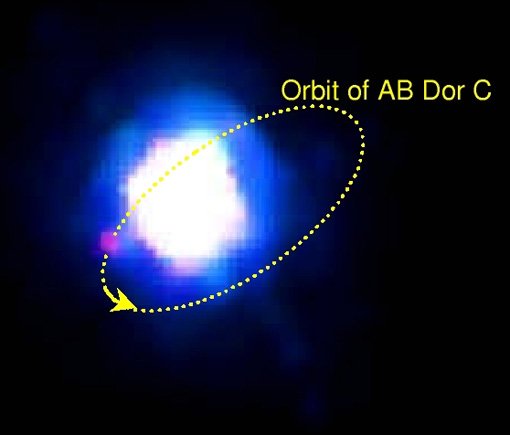First Direct Evidence Says: Young, very Low Mass Objects Are Twice as Heavy as Predicted
Although mass is the most important property of stars, it has proved very hard to measure for the lowest mass objects in the Universe. Thanks to a powerful new camera a very rare low-mass companion has finally been photographed. The discovery suggests that, due to errors in the models, astronomers have overestimated the number of young "brown dwarfs" and "free floating" extrasolar planets.
An international team of astronomers lead by Laird Close and Rainer Lenzen report their discovery in today's (Jan 20.) issue of Nature. The image has allowed the team to directly measured the mass of a young, very low mass object for the first time. The object, more than 100 timesfainter than its close primary star, is 93 times as massive as Jupiter - almost twice as heavy as theory predicts it should be. Their findings challenge current ideas about the astronomical "brown dwarf" population and the existence of widely publicized "free-floating" extrasolar planets.
Brown dwarfs are objects 75 times more massive than Jupiter but not massive enough to burn as stars. If young objects identified as brown dwarfs are twice as massive as has been thought, many actually are low mass stars. Objects recently identified as "free-floating" planets are in turn likely just low mass brown dwarfs.
Laird Close of the University of Arizona's Steward Observatory, Rainer Lenzen of the Max Planck Institute for Astronomy in Heidelberg and their international colleagues detected the faint, very-low-mass companion (named AB Dor C), which orbits the very young star AB Doradus A (AB Dor A) at only 2.3 times the distance between the Earth and the Sun, or about the distance between the Sun and the asteroids beyond Mars.
Astronomers searching for very low mass objects look at young nearby stars because low mass companion objects will be brightest when young, before they contract and cool. Astronomers had suspected since the early 1990s that well-known AB Dor A - a star 48 light years from Earth and only 50 million years old - has a low-mass companion since its position is "wobbling" as it is pulled on by an unseen companion. But even the Hubble Space Telescope tried and failed to detect it, since the companion was too faint and too close to the glare of the primary star.
Close, Lenzen and their colleagues from Germany (Wolfgang Brandner), Spain (José C. Guirado), Chile (Markus Hartung, Chris Lidman), and USA (Eric Nielsen, Eric Mamajek, and Beth Biller) succeeded in photographing the elusive companion by using Close and Lenzen's novel "high contrast" camera on the European Southern Observatory's 8.2-meter Very Large Telescope in Chile in February 2004. Close and Lenzen developed the new high-contrast adaptive optics camera, the NACO Simultaneous Differential Imager, or NACO SDI, for hunting extrasolar planets. The SDI camera enhances the ability of the powerful 8 meter VLT telescope and its existing adaptive optics system to detect faint companions that normally would be lost in the glare of the primary star.
This image is the first of a companion so faint - 120 times fainter- and so near to its primary star. The tiny angular distance between the star and the faint companion (0.156 arcseconds) corresponds to the apparent size of a dime seen 8 miles (or 13 km) away. Once the located the companion, called AB Dor C, they observed it at near infrared wavelengths to measure its temperature and luminosity.
"We were surprised to find that the companion was 400 degrees Celsius cooler and 2.5 times fainter than the latest models predicted," Close said. "We used our discovery of the companion's exact location, along with the star's known 'wobble', to accurately determine the companion' mass," said team member Jose Guirado."Theory predicts that this low-mass, cool object would be about 50 Jupiter masses. But theory is incorrect: This object is between 88-98 Jupiter masses," Close said. "This discovery will force astronomers to rethink what masses of the smallest objects produced in nature really are."
"Objects like AB Dor C are very rare. Only 1 % of stars have close very low mass companions - and only about 1 % of nearby stars are young - hence we are very lucky to be able to accurately measure the mass of even a single low mass companion that is accurately known to be young," Wolfgang Brandner said.
The NACO SDI camera is a unique type of camera using adaptive optics, which removes the blurring effects of Earth's atmosphere to produce extremely shape images. SDI splits light from a single star into four identical images, then passes the resulting beams through four slightly different methane-sensitive filters. When the filtered light beams hit the camera's detector array, astronomers can subtract the images so the bright star disappears, revealing a fainter, lower-mass methane-rich object otherwise hidden in the star's scattered light halo.
The National Science Foundation awarded Close a prestigious 5-year, $ 545,000 Faculty Early Career Development award that supports his search for extrasolar planets using SDI cameras on the European Southern Observatory's 8.2-meter VLT in Chile and on the UA/Smithsonian 6.5-meter MMT on Mount Hopkins, Arizona. This research was also supported by a NASA grant as well.
Authors of the Jan. 20 Nature letter, "A dynamical calibration of the mass-luminosity relation at very low stellar masses and young ages," are:
Laird Close, Steward Observatory, University of Arizona,
Rainer Lenzen, Max Planck Institute for Astronomy, Heidelberg,
José C. Guirado, University of Valencia (Spain),
Eric L. Nielsen, Steward Observatory, University of Arizona,
Eric E. Mamajek, Harvard-Smithsonian Center for Astrophysics,
Wolfgang Brandner, Max Planck Institute for Astronomy, Heidelberg,
Markus Hartung and Chris Lindman, European Southern Observatory (Chile),
Beth Biller, Steward Observatory, University of Arizona

